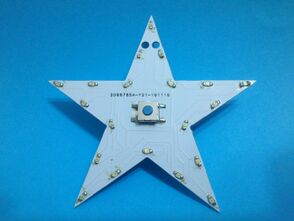LedShapesEnglish
| project overview | |

| |
| Year | 2019-2024 |
| Number of pixels | 18-20 |
| Grayscales / Colors | greyscales |
| Illuminant | SMD LEDs |
| Power input | |
| Contact person | Arne Rossius |
| Project website | |
The LED Shapes are various shapes (currently a heart, an arrow, and a star are available) defined by several LEDs forming their outline. They are the successor of the AntiKippenLights project, now using a smaller 8-pin microcontroller and Charlieplexing to control the up to 20 LEDs forming the shape. As before, several animations with and without fading are played on the LEDs in succession. Power is supplied by a CR2032 3 V lithium button cell. The circuit can be switched on and off with a button, and also turns off by itself after approx. 2 hours of continuous operation.
Hardware
The heart and arrow PCBs kept their 45.7 x 30.5 mm dimensions from AKL-Mini, to fit into a matchbox. They both use 18 LEDs as before. The star PCB is itself star-shaped and has 20 LEDs arranged around its edge. The layouts are double sided and it's recommended to use thin PCB material (e.g. 1 mm).
Rev. 4.0
- Schematic for 18 LEDs (PNG image)
- Schematic for 20 LEDs (PNG image)
Heart
- Schematic (EAGLE 4.x)
- PCB layout (EAGLE 4.x)
- PCB layout (Gerber files)
- Construction kit instructions
Arrow
- Schematic (EAGLE 4.x)
- PCB layout (EAGLE 4.x)
- PCB layout (Gerber files)
- Construction kit instructions
Star
- Schematic (EAGLE 4.x)
- PCB layout (EAGLE 4.x)
- PCB layout (Gerber files)
- Construction kit instructions
Rev. 3.0 (Star only)
- Schematic (PNG image)
- Schematic (EAGLE 4.x)
- PCB layout (EAGLE 4.x)
- PCB layout (Gerber files)
- Construction kit instructions
Software
For Hardware Rev. 4.x
For use with Padauk PMS150C, PMS150G or PFS154 controllers.
This version adds two new modes of operation. For normal operation, insert the battery, then press the button to turn the LED shape on, press again to turn it off. If the LED shape is left on, it will automatically turn off after approx. 2 hours (same as Rev. 3.x).
To disable the automatic power-off function, hold down the button while inserting the battery. Release the button when all LEDs light up (approx. 1 second after inserting the battery). To re-enable the automatic power-off function, remove the battery and hold down the button for a few seconds to discharge the capacitor, then re-insert the battery (with the button released).
In test mode, the LEDs light up one by one in sequence, to find and fix hardware faults (e.g. bad soldering or LEDs installed the wrong way around). To enter test mode, hold down the button while inserting the battery, but do not release it when all LEDs light up. Keep holding the button down until the test mode starts (approx. 5 seconds after inserting battery). To exit test mode, remove the battery.
- Version 4.4 (2024-01-10) for AS (asl). The binary output is identical to v4.3.
- Version 4.3 (2022-02-13) for SDCC version 4.1.0 (doesn't assemble correctly with SDCC v4.2.0 or later!)
The generated binary file from either version can be written to the microcontroller with the Easy PDK Programmer (hardware, software).
For Hardware Rev. 3.x
For use with Atmel/Microchip ATtiny13(A) controllers. Only available for 20 LEDs.
Prototypes
Star
The first prototype built was for the star shape, using an ATtiny13 microcontroller. It uses THT components except for the LEDs to enable it being built on a home-etched single layer PCB. After successful testing, an SMD-only PCB was designed and became available as LED-Star v3.0.
Arrow
The second prototype built was an arrow using 20 LEDs, this time using a low-cost Padauk microcontroller. It is using only THT components, the microcontroller is mounted on an adapter PCB to fit into a standard IC socket. The prototype PCB is compatible with at least the PMS150C, PMS150G and PFS154 controllers, the latter being used during development as it has reprogrammable flash memory.
Heart
The third prototype built was the traditional heart shape copied from AKL-Mini, but also using the Padauk microcontroller. A single-sided PCB was designed for easier home etching, requiring several wire bridges on the reverse and also using a THT battery holder.


